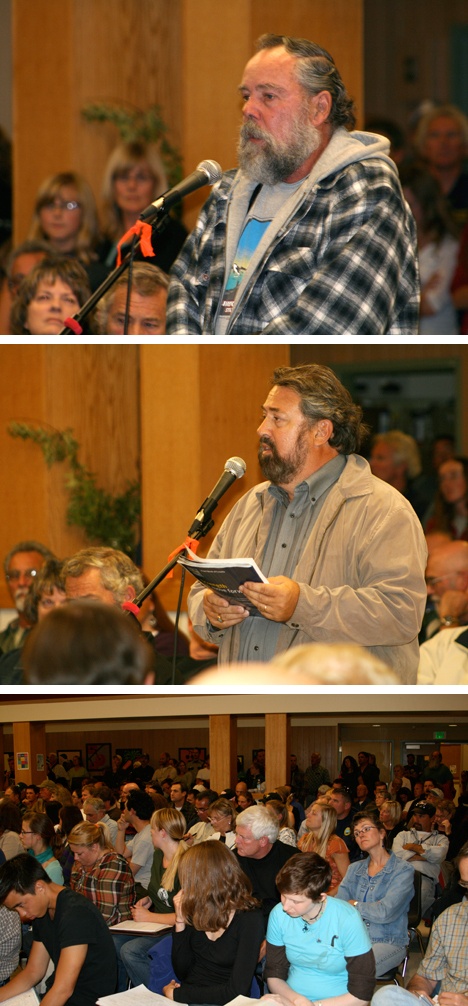Beloved. Endangered. Exploited. Revered.
Puget Sound’s killer whales may be all that and more.
But it will be an uphill battle for federal officials in their bid to create bigger buffers between boats, kayaks, canoes and the struggling population of Southern Resident killer whales. And in the realm of public opinion, a proposal to establish a half-mile “no-go zone” off the west side of San Juan Island during the summer season has proven even less popular.
“Current regulations need to be enforced before adding more,” Friday Harbor’s Jeanne Hyde said of the more stringent package of proposed rules. “The whales need salmon to survive, not more regulations.”
On Monday, the National Marine Fisheries Service drew another standing-room-only crowd, this time in Friday Harbor, as it conducted its third and final public forum on a proposal to expand on-the-water protections for the Southern Residents, listed as endangered under federal law in late 2005. Nearly 90 people took advantage of two minutes of alloted time each to weigh in on the newly-proposed regulations and, as was the case in Anacortes and in Seattle, opposition was plentiful.
“Kayaks don’t make noise,” said Clark Casebolt, owner/operator of Outdoor Odyssey, which for 20 years has offered guided kayak tours from San Juan Island’s west side. “Nor do we chase the whales. We couldn’t even if we wanted to.”
The Southern residents, which include J, K and L pods, dropped from 97 to 88 animals in six-year decline beginning in 1996. The population today is 85.
According to Lynne Barre of the fisheries service, tasked with developing a recovery plan for the Southern Residents, the agency determined existing regulations, which prohibit vessels from approaching with 100 yards of killer whales, are insufficient to protect the Southern Residents from vessel impacts. Impacts include engine noise, which reportedly limits the ability of a killer whale to use echolocation in locating prey; lack of prey, meaning salmon; and pollution, according to NMFS.
“When vessels are farther away, the impacts go down,” Barre said. “We want to do everything we can to help the whales find salmon without expending extra energy.”
As proposed, the new rules would prohibit vessels, including kayaks, from approaching within 200 yards of any killer whale and within 400 yards of an oncoming orca. It would also establish a half-mile no-go zone along the west side of San Juan Island, from Mitchell Bay at the north to Eagle Point at the south, which would be in effect from the beginning of May through the end of September. Deadline for public comment is Oct. 27.
Many who testified at Monday’s meeting fault the fisheries service and its parent agency, the National Oceanic and Atmospheric Administration, for failing to enforce the 100-yard distance.
“You can’t say the present guidelines don’t work if they haven’t been enforced,” commercial fisherman Troy Liljebald said.
Others, like Ken Balcomb, director of the Center for Whale Research, believe the fisheries service is wasting its energy crafting new vessel regulations.
“We’re off-course,” Balcomb said. “What the whales need is more salmon. It doesn’t make any difference to me if you pass these regulations or not, nor does it make any difference to the whales.”
Monika Wieland, a naturalist with Friday Harbor-based whale-watch company Western Prince, added, “I wish this much energy was being put into salmon recovery, the real deal-breaker for the orcas.”
Nearly all who testified at Monday’s meeting prefer to see a “slow-go” zone off the west side of San Juan Island, as well as greater enforcement of a speed limit, such as 7 knots, rather than a “no-go” zone. The 200-yard distance, however, drew the support of many, including the staff and board of directors of Friday Harbor’s Whale Museum.
While the organization supports wider buffers, Whale Museum Director Jenny Atkinson said it also views NOAA’s proposal as a work in progress.
“It’s important that we give our whales as much protection as we can on every front,” Atkinson said. “Everyone has to give a little.”




